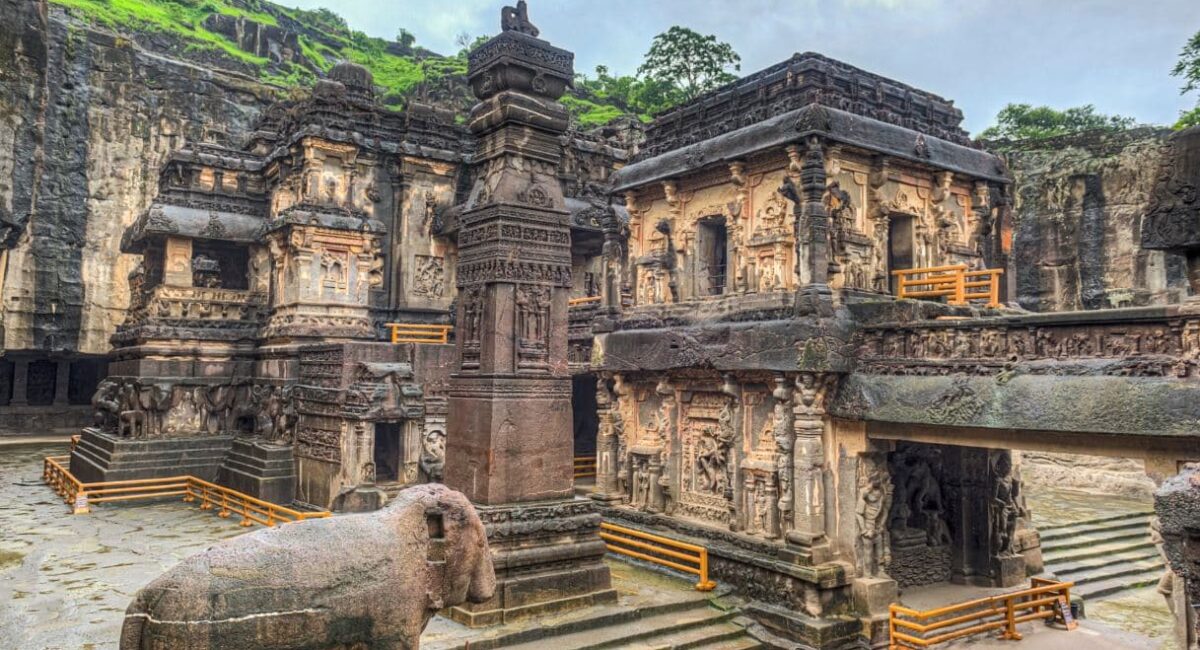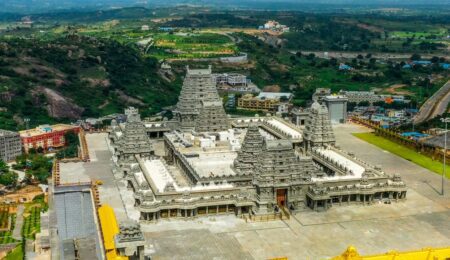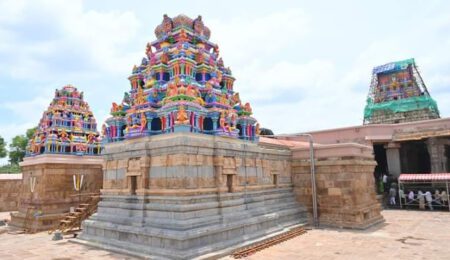Kailasa Temple in Ellora, Maharashtra: An Eternal Marvel of Rock-cut Architecture
The Kailasa Temple, also known as Kailasanatha Temple, stands as one of the greatest architectural wonders of ancient India. Carved out of a single monolithic rock, this marvel is located in Ellora, Maharashtra, and is a shining example of India’s rich cultural, architectural, and spiritual heritage. It is considered one of the largest and most impressive rock-cut temples of India, and a must-visit for historians, pilgrims, and tourists alike.
The temple is an embodiment of faith, vision, artistic skill, and engineering prowess. Its sheer scale, intricate carvings, and method of construction make it stand apart from any other ancient structure in the world. The story of Kailasa Temple is not just a tale of stone and chisel, but of divine devotion and human perseverance.
Historical Background of Kailasa Temple Ellora
The Kailasa Temple is part of the Ellora Caves, a UNESCO World Heritage Site and one of the most important archaeological complexes in India. The temple is Cave 16 among the 34 rock-cut temples and monasteries that span Hindu, Buddhist, and Jain traditions, dating from the 6th to 10th centuries CE.
- Commissioned by: The temple was commissioned in the 8th century by the Rashtrakuta king Krishna I.
- Time Period: It is believed to have been constructed between 756 and 773 CE.
- Purpose: Built to honor Lord Shiva, the temple is a representation of Mount Kailash, the mythical abode of Shiva.
- Dynastic Contribution: Apart from Krishna I, later rulers including Dantidurga and Govinda III may have contributed to the enhancements of the temple.
The Rashtrakuta dynasty was one of the most powerful empires of ancient India and was known for its military prowess as well as cultural patronage. The construction of the Kailasa Temple represented not just spiritual devotion, but also a political statement of grandeur and power.
Architectural Brilliance
The Kailasa Temple is widely regarded as one of the most remarkable feats of rock-cut architecture ever attempted. Unlike traditional construction where blocks are placed one over another, this temple was carved out of a single massive volcanic rock using a subtractive process.
Key Features:
- Monolithic Structure: The entire temple complex is carved from a single rock, making it the largest monolithic rock-cut structure in the world.
- Dimensions: The temple measures about 276 feet long, 154 feet wide, and rises to a height of 100 feet.
- Intricacy of Design: The main shrine, Nandi Mandapa, various subsidiary shrines, galleries, and life-sized elephant sculptures all reflect minute detailing.
- Pillars and Mandapas: The temple complex includes exquisitely carved columns, balconies, pillared halls, and multi-tiered towers.
- Friezes and Reliefs: Scenes from Hindu mythology including battles from the Ramayana and Mahabharata are carved into the walls.
- Design Layout: The temple layout includes the entrance courtyard, Nandi Mandapa, a multi-level gateway, and the central sanctum with the linga.
The fact that no scaffolding or support systems were used and the rock was chiseled from top to bottom in layers is a testament to the engineering genius of the era.
Religious Significance
Kailasa Temple is not merely a monument but a living temple that has sustained religious relevance for over a thousand years.
- Primary Deity: Lord Shiva in the form of a lingam is worshipped in the central sanctum.
- Mythical Representation: The temple is designed to represent Mount Kailash, believed to be the heavenly residence of Lord Shiva and Parvati.
- Ritualistic Importance: Regular pujas and rituals are conducted, particularly on Shivratri, which sees an influx of thousands of pilgrims.
The temple’s carvings, from Shiva in cosmic dance (Nataraja) to Shiva defeating demons, depict his roles as creator, destroyer, and protector, making the site spiritually rich.
Myths and Legends
Several fascinating legends surround the creation of Kailasa Temple, blending folklore with history and spirituality:
- Legend of the Queen’s Vow: It is believed that a queen made a vow to build a temple if her husband recovered from a deadly illness. The architects, to meet the queen’s vow to see the shikhara first, began excavation from the top of the rock to the bottom.
- Creation in a Week: One popular local myth suggests that the temple was built in just seven days, a feat impossible even with today’s machinery, emphasizing divine intervention.
- Sculptor Kokasa: Some texts and inscriptions attribute the design and execution of the temple to a legendary architect named Kokasa, believed to have supernatural skills.
- Connection to Gods: Locals believe that the construction was aided by divine beings or celestial forces, explaining the temple’s perfection.
These stories continue to captivate visitors and lend the temple a mystical aura.
Theories of Construction
How was Kailasa Temple built? Modern engineers, archaeologists, and historians still marvel at its creation. Several theories attempt to explain the temple’s construction methodology.
Key Theories:
- Vertical Excavation: Unlike traditional horizontal carving, artisans excavated the rock from top to bottom, reducing the risk of collapse.
- Massive Labor Force: Experts suggest a workforce of over 7,000 laborers working for decades to carve the entire structure.
- Tool Limitations: Only iron chisels and hammers were available, which makes the detailed and symmetrical carving even more astounding.
- No Blueprints: There is no evidence of architectural blueprints or pre-planning, which raises questions about how such precision was achieved.
- Acoustic and Optical Design: The temple’s chambers have specific acoustic properties that enhance chanting, and strategic skylights illuminate inner sanctums naturally.
The absence of debris piles and the lack of visible errors also fuel speculation about lost construction techniques or advanced ancient knowledge.
UNESCO World Heritage Site Status
Ellora Caves, home to the Kailasa Temple, were recognized by UNESCO in 1983 for their cultural significance and architectural mastery.
Why UNESCO Recognized It:
- Masterpiece of Creativity: The temple is a prime example of artistic innovation and human ingenuity.
- Religious Harmony: The site features temples from Hindu, Buddhist, and Jain traditions, reflecting India’s religious diversity.
- Architectural Grandeur: The engineering and planning involved in carving such a vast structure from a single rock is unmatched.
The designation as a World Heritage Site has led to better conservation, research funding, and global awareness of this Indian treasure.
Tourist Information
Kailasa Temple Ellora is a top tourist destination and a favorite among spiritual seekers, history enthusiasts, and photographers.
How to Reach:
- By Air: The nearest airport is Ch Sambhaji Nagar, about 30 km away, which is well connected to Mumbai, Delhi, and Hyderabad.
- By Train: Ch Sambhaji Nagar Railway Station is the nearest major railhead with regular trains from major Indian cities.
- By Road: Government and private buses, rental taxis, and autos are available from Ch Sambhaji Nagarto Ellora.
Best Time to Visit:
- Ideal Season: October to March offers pleasant weather for exploring.
- Festivals: Visiting during Maha Shivaratri or Ellora Festival (cultural event) enhances the experience with spiritual and cultural performances.
Entry Fees and Timings:
- Indians: INR 40 per person
- Foreigners: INR 600 per person
- Children below 15 years: Free entry
- Visiting Hours: 6:00 AM to 6:00 PM (Closed on Tuesdays)
Visitor Tips:
- Wear light, breathable clothes and comfortable footwear.
- Hire a local guide for in-depth historical context.
- Avoid mid-day visits during summer to escape the heat.
- Respect the sanctity—avoid touching or defacing sculptures.
- Carry drinking water and keep the premises clean.
Lesser-Known Facts about Kailasa Temple
- The temple has over 100 intricately carved panels that are not found in any historical texts.
- There are hidden underground passages, some of which are now sealed.
- Sculptures of elephants at the base seem to bear the weight of the temple symbolically.
- Despite being carved out of rock, the temple has well-planned water drainage systems.
- An aerial view of the temple shows its layout resembles a mandala, a sacred geometric symbol.
Reflection: The Legacy and Mystery of the Kailasa Temple Ellora
The Kailasa Temple continues to be a source of inspiration, wonder, and spiritual strength. It is a living example of what human determination, spiritual vision, and artistic excellence can achieve—even with limited resources.
Even after more than a millennium, the temple evokes the same awe and reverence it must have inspired during its inception. It challenges our assumptions about ancient civilizations and reminds us of the timeless essence of devotion and creativity.
Kailasa Temple is not merely a place to visit but a place to experience. It invites visitors to explore the intersection of myth, science, history, and faith. In a world increasingly dominated by speed and transience, the temple stands still—rooted in stone and spirit, echoing the eternal.
If you ever plan to explore the rock-cut temples of India, let the Kailasa Temple in Ellora, Maharashtra, be the first on your list. It is not just a marvel of the past—it is a guiding light for the future.




Leave a Comment